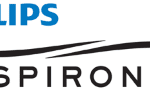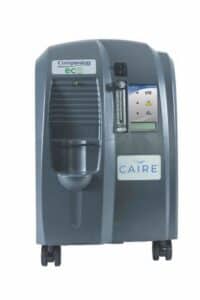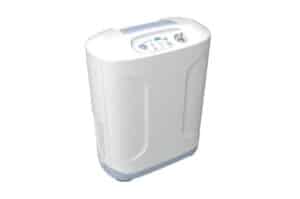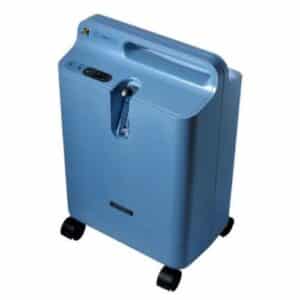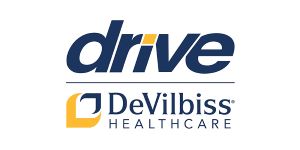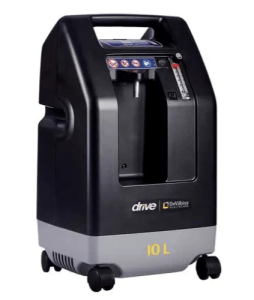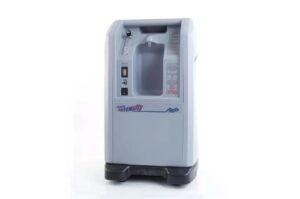The CAIRE Companion 5 is the most budget-friendly HOC model on this list. On its highest setting, the machine only consumes 350 watts of power, which saves energy and makes it our Reviews Team’s “Best Value” pick.
6 Best Home Oxygen Concentrators of 2024
If you have a chronic respiratory condition—such as asthma, chronic obstructive pulmonary disease (COPD), lung disease, or obstructive sleep apnea (OSA)—you may not receive enough oxygen. According to the U.S. Food & Drug Administration (FDA), healthy blood oxygen saturation levels fall at about 95% or higher. [1]U.S. Food and Drug Administration. Pulse Oximeter Accuracy and Limitations: FDA Safety Communication. Nov. 7, 2022. Found on the internet at https://www.fda.gov/medical-devices/safety-communications/pulse-oximeter-accuracy-and-limitations-fda-safety-communication Respiratory conditions can make it difficult to meet those levels.
Supplemental oxygen devices, like home oxygen concentrators (HOCs) or portable oxygen concentrators (POCs), can help raise your blood oxygen levels. The best HOC for you depends on your oxygen prescription and individual preferences.
To help guide you in your search for the best HOC, our Reviews Team analyzed several, ranking them based on price, weight, sound level, and mobility.
A quick look at the best home oxygen concentrators in 2024
- CAIRE Companion 5: Best Value
- Inogen At Home 5L: Most Energy Efficient
- Respironics EverFlo Q Home Concentrator: Quietest
- Drive DeVilbiss 10L Home Oxygen Concentrator: Best 10L
- CAIRE AirSep Newlife Intensity 10: Best for Long-Term
- Inogen One G5: Lightest
CAIRE Companion 5
Inogen At Home 5L
Respironics EverFlo Q Home Concentrator
Drive DeVilbiss 10L Home Oxygen Concentrator
CAIRE AirSep Newlife Intensity 10
Inogen One G5
Oxygen Concentrator Store customer service
Some of the oxygen concentrators in this review are available through the online retailer Oxygen Concentrator Store. You can contact the customer service department in the following ways:
- Phone: (844-885-9530), available 365 days a year on the following schedule:
- 6 a.m. to 9 p.m. MT Monday through Friday
- 7 a.m. to 7 p.m. MT Saturday
- 8 a.m. to 7 p.m. MT Sunday
- Email: (service@amsrco.com)
- Online chat: On the OCS support page
- Contact form: Submit an online ticket on the contact form, and a representative will respond within one business day. The Oxygen Concentrator Store website also has a detailed product support page with information on cleaning, maintenance, and use of oxygen concentrators.
Our Reviews Team’s customer service experience
The Oxygen Concentrator store offers a chat feature, and customer service was very responsive to our reviewer’s questions. The customer service representative said most HOCs last about five years. They also recommended wiping the external vents down monthly to keep the machine operating properly.
Shipping takes about three to five business days, but Oxygen Concentrator Store also offers two-day and overnight shipping for an additional cost.
What is a home oxygen concentrator?
A home oxygen concentrator is a medical device used to provide supplemental oxygen for those with breathing conditions, such as lung cancer, asthma, or COPD. Unlike an oxygen tank, these devices use electrical pumps to filter nitrogen from the air around you and concentrate oxygen levels. You’ll need a prescription for a home oxygen concentrator, and it’s important to speak with your doctor about appropriate use.
How does a home oxygen concentrator work?
HOCs extract air from the room, filter it, and deliver purified air through a nasal cannula, a long tube running from the device to your nostrils. Those requiring a high oxygen flow, which is about 3 liters per minute or more, benefit from continuous-flow oxygen devices, according to the American Thoracic Society. [4]Jacobs S, Krishnan J. Annals of the American Thoracic Society. September 2021. Patients Choose Hypoxemia Over Social Isolation. Found on the internet at https://www.atsjournals.org/doi/full/10.1513/AnnalsATS.202106-676ED Your medical condition and prescription determine the best flow level for your needs.
You can use a HOC while you are awake or asleep. Some work well with CPAP machines to support you if you have sleep apnea.
Oxygen flow types
Stationary HOCs offer a consistent oxygen flow, while pulse flow portable models provide oxygen every time you inhale, according to a comparison of supplemental oxygen therapies. [5]Gloeckl R, et al. Respiratory Medicine. September 2019. Comparison of Supplemental Oxygen Delivery by Continuous Versus Demand Based Flow Systems in Hypoxemic COPD Patients – A Randomized, Single-blinded Crossover Study. Found on the internet at https://www.resmedjournal.com/article/S0954-6111(19)30258-6/fulltext Both machine types have different flow settings you can adjust on the concentrator. With some portable models, you may be able to change the settings from an app on your smartphone. Please check with your doctor before making adjustments to oxygen levels.
Who should use a home oxygen concentrator?
People with chronic respiratory diseases or those who don’t get enough oxygen benefit from using a home oxygen concentrator. You may need one if you have asthma, COPD, emphysema, heart failure, or other health conditions. Low oxygen levels can lead to shortness of breath, chest pain, confusion, balance issues, headache, dizziness, and other symptoms.
“For some, their health condition results in such low oxygen that they are at serious risk without supplemental oxygen. For others, such as those who have COPD and have a low resting oxygen level, supplemental oxygen reduces the risk of them developing pulmonary hypertension, and therefore improves both their quality of life and their prognosis,” said Praveen Bhatia, MBBS, a respiratory medicine physician and sleep medicine expert in Manchester, United Kingdom.
You must get a prescription from your health care provider to buy a HOC. Your doctor will determine whether you need a pulse or continuous-flow oxygen concentrator and how often to use it.
If you are often on the go or traveling, you might find a travel CPAP works better for you.
What to consider before buying
The best machine for you will depend on your prescribed oxygen needs, lifestyle, and other preferences. Before buying, you should consider a few factors:
- Product quality: Check verified customer reviews for durability, longevity, and other concerns.
- Oxygen output: Pick a model that can deliver your oxygen prescription.
- Size and weight: Consider machines that fit comfortably near your couch or bed and fit well in your space.
- Display type: Decide if you like LED screens, lights, or audible alarms.
- Mobility: Consider how easy it will be to move. Built-in handles and wheels help move your device from room to room when not in use.
- Extra features: Some HOCs and POCs have technology like apps you can download to your smartphone to track oxygen levels and adjust airflow levels.
How much do home oxygen concentrators cost?
The HOCs we reviewed range in price from $595–$2,650. The price does not appear to be related to size, as the smallest model was the most expensive. The cost varies with accessories and warranty length and coverage. The most affordable model on this list is the CAIRE Companion 5 Home Concentrator.
Does insurance cover home oxygen concentrators?
Depending on your plan and provider, private insurance may cover some or all of your HOC costs. Contact your insurance carrier before buying to see about reimbursement. Your health care provider will be required to complete paperwork and provide documentation on the medical necessity of an HOC. Your local State Health Insurance Assistance Program (or SHIP) can help if you have questions about this requirement.
Does Medicare cover home oxygen concentrators?
Oxygen machines are considered durable medical equipment (DME)ⓘ Durable medical equipment (DME): Medical equipment expected to last at least three years, prescribed for in-home use for a medical reason. , so Medicare Part B may cover some of the cost of a rental HOC. For Medicare to help pay for your oxygen, your doctor will need to prescribe oxygen, prove that supplemental oxygen may improve your condition, and document that your blood oxygen often falls below acceptable levels. See Medicare.gov for more information. [6]Centers for Medicare and Medicaid Services. Home Use of Oxygen. Found on the internet at https://www.cms.gov/medicare-coverage-database/view/ncd.aspx?NCDId=169
Table 1, Comparison of the best home oxygen concentrators
|
CAIRE Companion 5
Check Price
|
Inogen At Home 5L
Check Price
|
Respironics EverFlo Q Home Concentrator
Check Price
|
Drive DeVilbiss 10L Home Oxygen Concentrator
Check Price
|
CAIRE AirSep Newlife Intensity 10
Check Price
|
Inogen One G5
Check Price
|
|
|---|---|---|---|---|---|---|
| Best For | Best Value | Most Energy Efficient | Quietest | Best 10-liter | Best for Long-Term | Lightest |
| Equipment cost | $595 | $1,645 | $649 | $1,399 | $1,895 | $2,882 |
| Oxygen purity | 85%–95% | 87%–96% | 93% | 87% – 96% | 87%–93% | 90% |
| Decibels | 50 | 52–56 at setting of 2 | 40 | 69 | 55 | 38 |
| Max oxygen output | 5 liters per minute | 5 | 5 | 10 | 10 | 1.26 |
| Mobility | Includes wheels | No wheels or handle | Includes wheels and a handle | Includes wheels and handle | Includes wheels and a handle | No handle or wheels |
*Cost at the time of publication of this article. If you live in Massachusetts or New Jersey, you may see a higher price for your oxygen concentrator. These states require a licensed respiratory therapist to deliver, set up, and titrate (adjust the oxygen dose of) your concentrator.
How we chose the best home oxygen concentrators
Our Reviews Team consulted with three geriatric care experts and one respiratory therapist to learn more about home oxygen concentrators and how they can enhance users’ quality of life. Based on our expert consultations and research, we found various factors important for our readers when shopping for a portable oxygen concentrator unit, including cost, ease of use, oxygen delivery method, and more. We had all our selections medically reviewed by an expert in the field to ensure each brand and model meets our readers’ needs.
Bottom line
The best home oxygen machine for your needs will depend on a variety of factors. There are multiple options to choose from, and each brand and model has its own benefits and drawbacks. To find the best oxygen machine for home therapy use, consider the price, the amount and purity of oxygen your prescription requires, and whether noise or portability is a concern. Your doctor or respiratory therapist may have a recommendation for what type of home oxygen concentrator is best for you or if there are certain features you should look for.
We selected the CAIRE Companion 5 Home Concentrator for budget-conscious people as “Best Value.” We recommend the Nidek Nuvo Lite Mark 5 Liter if you’re looking for a quiet model. We chose the Invacare Platinum 10 Liter HOC for those with high oxygen needs. Consider the Inogen At Home 5L Concentrator if you’re looking for an energy-efficient machine. For people looking for a long-lasting model, consider the CAIRE AirSep Newlife Intensity 10. If you’re looking for an oxygen concentrator you can use on the go, our Reviews Team recommends the Inogen One G4 POC.
Frequently asked questions
Although you can purchase some oxygen concentrators online, you should get a prescription from a health care provider to determine which model would work best for you and how much supplemental oxygen you need.
The oxygen concentrators we reviewed range in cost from $695–$2,948. The only portable oxygen concentrator on this list costs the most.
A stationary oxygen concentrator is best for home use. The stationary models can provide continuous oxygen using AC power and can run all day and night, even while sleeping. Many home models have built-in handles and wheels for easy transport when not in use.
No, you cannot buy oxygen concentrators over-the-counter or without a prescription. Over-the-counter oxygen canisters are available for purchase without a prescription, but they aren’t a replacement for medical-grade prescription supplemental oxygen. Instead, these small, hand-held oxygen tanks are designed for athletic support and to ease symptoms of altitude sickness, hangovers, or jet lag.
Stationary oxygen concentrators must be plugged in to function, so you a need backup electricity source in case of a power outage. Consider getting a power generator for these events. Home concentrators can also be quite large and hard to move.
Have questions about this review? Email us at reviewsteam@ncoa.org.
Sources
- U.S. Food and Drug Administration. Pulse Oximeter Accuracy and Limitations: FDA Safety Communication. Nov. 7, 2022. Found on the internet at https://www.fda.gov/medical-devices/safety-communications/pulse-oximeter-accuracy-and-limitations-fda-safety-communication
- International Noise Awareness Day. Common Noise Levels – How Loud Is Too Loud? Found on the internet at https://noiseawareness.org/info-center/common-noise-levels/
- Khor Y, et al. European Respiratory Journal Open Research. Sept. 16, 2019. Oxygen Therapy in COPD and Interstitial Lung Disease: Navigating the Knowns and Unknowns. Found on the internet at https://openres.ersjournals.com/content/5/3/00118-2019
- Jacobs S, Krishnan J. Annals of the American Thoracic Society. September 2021. Patients Choose Hypoxemia Over Social Isolation. Found on the internet at https://www.atsjournals.org/doi/full/10.1513/AnnalsATS.202106-676ED
- Gloeckl R, et al. Respiratory Medicine. September 2019. Comparison of Supplemental Oxygen Delivery by Continuous Versus Demand Based Flow Systems in Hypoxemic COPD Patients – A Randomized, Single-blinded Crossover Study. Found on the internet at https://www.resmedjournal.com/article/S0954-6111(19)30258-6/fulltext
- Centers for Medicare and Medicaid Services. Home Use of Oxygen. Found on the internet at https://www.cms.gov/medicare-coverage-database/view/ncd.aspx?NCDId=169



